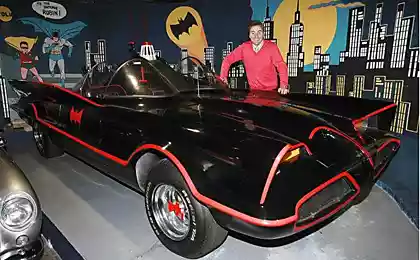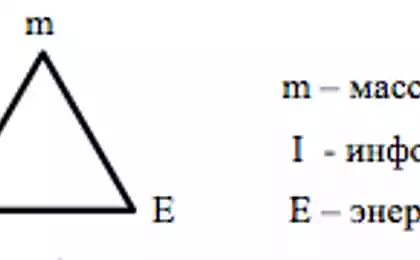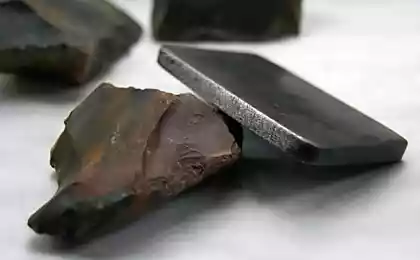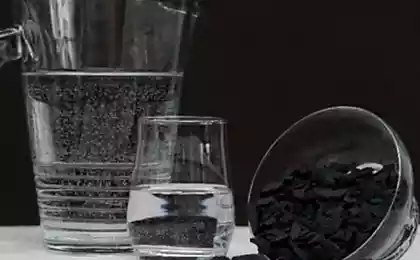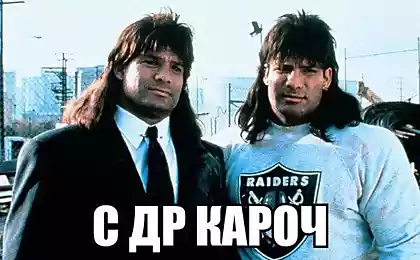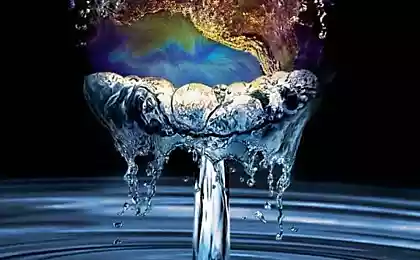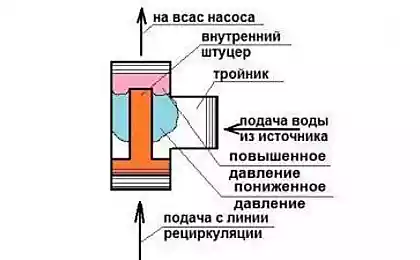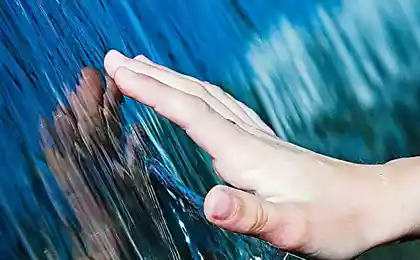963
Peter from the water
In addition to the post of Jus Peter from a height: a helicopter tour offers a practical parallel tour of the water.
It starts from the bridge at St John and Paul Fortress, duration 1 hour, cost 350 pe.
38 photos and a bit of text
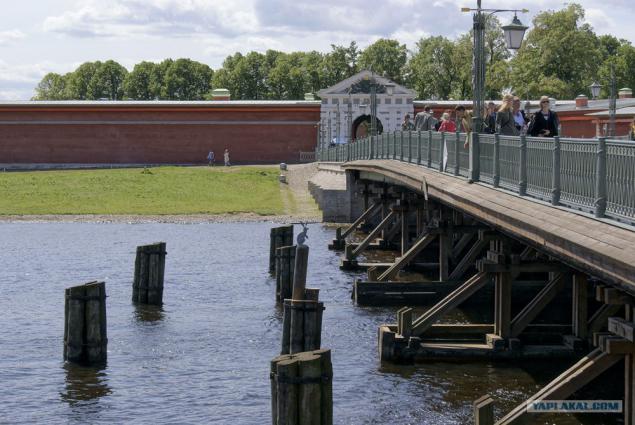
2. sailing past the bunny, which tourists leave coins.
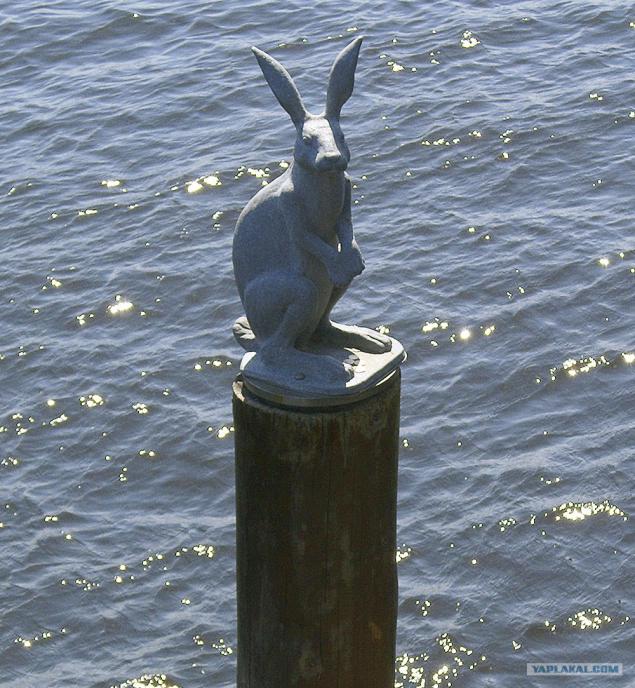
3. Marble Palace
In the years 1768-1785, designed by Antonio Rinaldi built the Marble Palace, which Catherine II gave to her favorite Grigory Orlov. The gift was made for active participation in the events Orlova 1762, as a result of which the Empress was on the Russian throne. Earl began to reciprocate a gift - a huge diamond weighing 189, 62 carats, named "Eagles».
According to legend, the empress herself made a sketch of the future building and showed it to the architect. Knowing that the project was Catherine Rinaldi praised the work and immediately received a building permit. The building incorporated October 10, 1769, at its foundation was immured marble box with coins. Construction work led by Colonel artillery MI Mordvinians. Architectural supervision exercised Petr Egorov. On the construction of the Marble Palace daily work of about 100 masons and from 100 to 300 artillery Fusiliers. Catherine II, periodically visit the construction site and personally awarded the most distinguished employees.
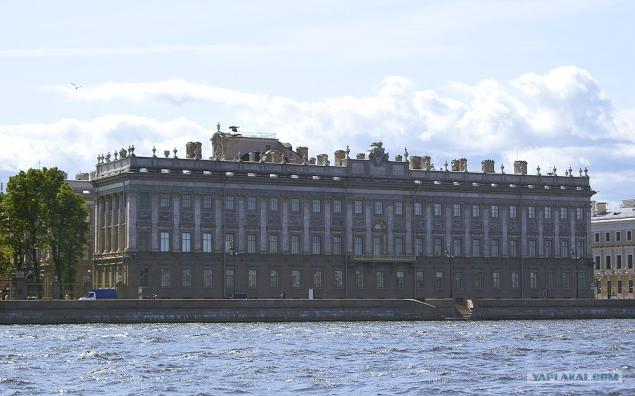
4. sailed under the Troitsky Bridge.
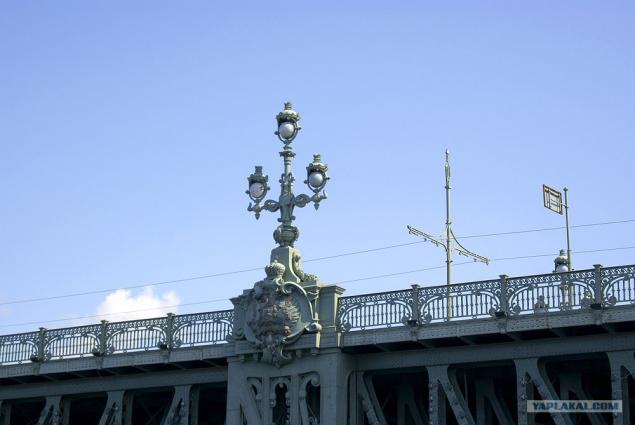
5. The official residence of the Russian President's plenipotentiary representative in the North-West Federal District. Ship restaurant.

6. The legendary "Aurora" and the building of Nakhimov Naval College, established in 1944 to orphans whose parents died in the Great Patriotic War.
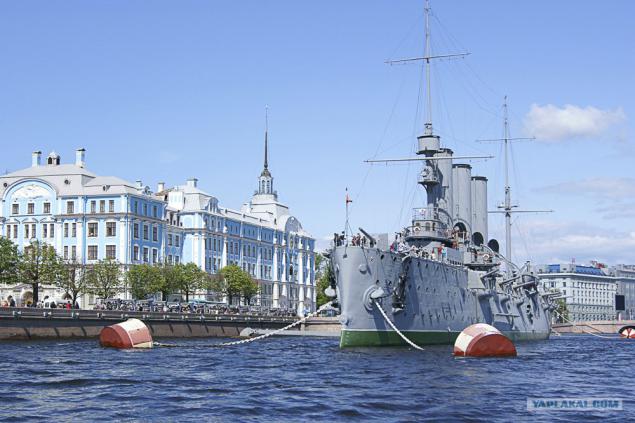
7. Foundry Bridge and the Big House (Foundry, etc., etc. 4).
Now the building of the FSB in St. Petersburg and Leningrad region. This house is dedicated detective television series "Foundry, 4" 2008. Earlier this place was the building of the District Court, burned in the February revolution.

8. Turn in the laundry room at the Fontanka River bridge. Right - Coffee House in the Summer Garden.
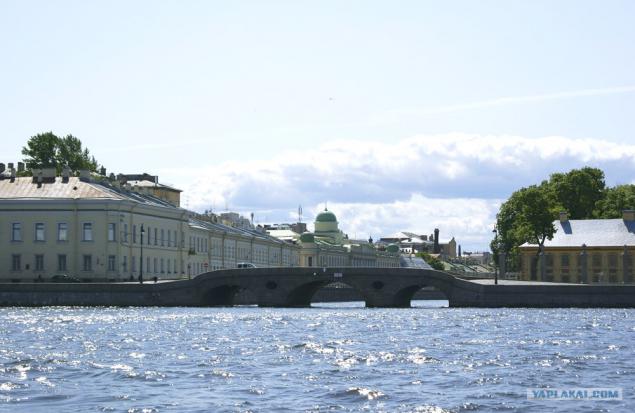
9. Laundry Bridge nazvyvaetsya so due to the fact that near - at the corner of St. Sergius Street (now the Tchaikovsky Street) and Fontanka - the palace was laundry.

10. On the territory of the Summer Garden, the site of the present house was Coffee Pavilion "Grotto", built in the years 1714-1725 and is now a monument of Peter the lost era. Who was its architect is unknown; however, suggest that it was one of the four famous architects of the time: A. Schluter, GI Mattarnovi, N. Michetti, M. Zemtsov.
In 1801, Groth was partially demolished on the orders of Paul I. After his murder the heir to the throne, Alexander I ordered to restore the building, but the drawings and plans for this were not enough. April 9, 1826 it was finally decided to rebuild the dilapidated Grotto.

11.
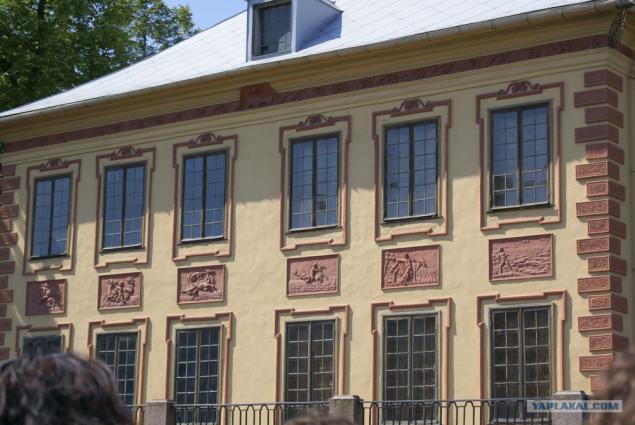
12.

13. Fontanka Embankment.
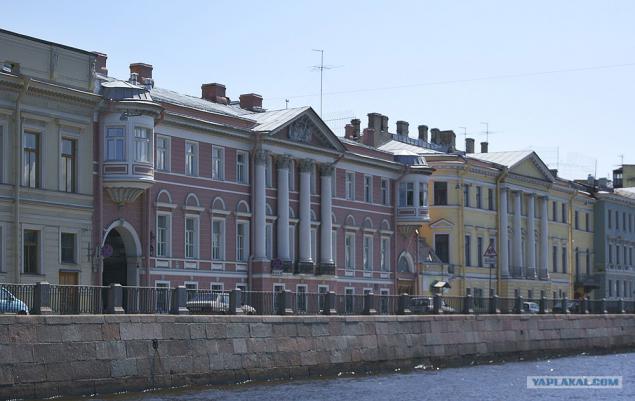
14. Mikhailovsky Castle.
His name Mikhailovsky Castle are therein shall temple of Archangel Michael, the patron saint of the Romanov dynasty, and fad Paul I, who took the title of Grand Master of the Order of Malta, called all his palaces "locks"; the second name - "Engineering" comes from being there since 1823. Main (Nicholas) Engineering School.
Beware of palace coups, Paul did not want to remain in the Winter Palace, determined to build his new residence. It is said that to reinforce the belief in the necessity of such a decision had spread a rumor that the soldiers standing at night on the clock in the Summer Palace, was a young man, surrounded by lights, who said: "Go to the Emperor and tell my will - so this place was erected a church and a house in the name of Archangel Michael. " The soldier, to be replaced from the post, reported the incident to his superiors, then the emperor. So supposedly and it was decided to build a new palace, it was given to him the name - St. Michael.
There is a legend associated with the murder of Paul in the castle: says that a few months before the death of the emperor appeared in St. Petersburg holy fool (according to some versions - Xenia of Petersburg), which foretold that to live it for so many years, how many letters in the inscription on the Iberian Gate a new palace . In the Biblical aphorism, "your house PODOBAET holy unto the Lord unto length of days" forty-seven characters. Forty-seventh year was Paul I, when he was killed.
The other, more well-known legend says that the ghost of the murdered emperor conspirators could not leave the place of his death. The ghost of the king began to see a platoon of soldiers garrison which transported military equipment, the new inhabitants of the palace - Diluting Corporal Ljamin school, and passers-by noticed the windows shining figure.

15. Castle, view from the Castle Street.
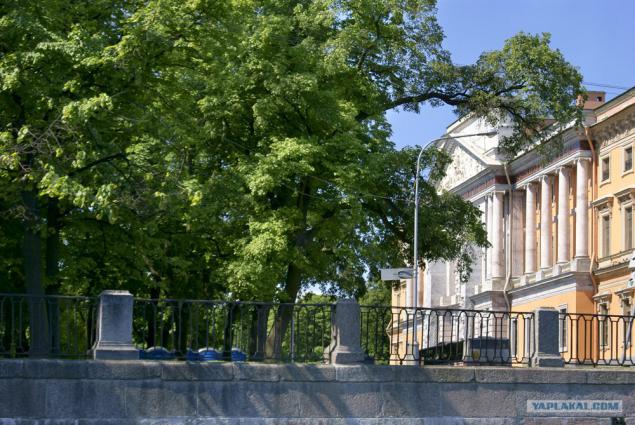
16. Circus
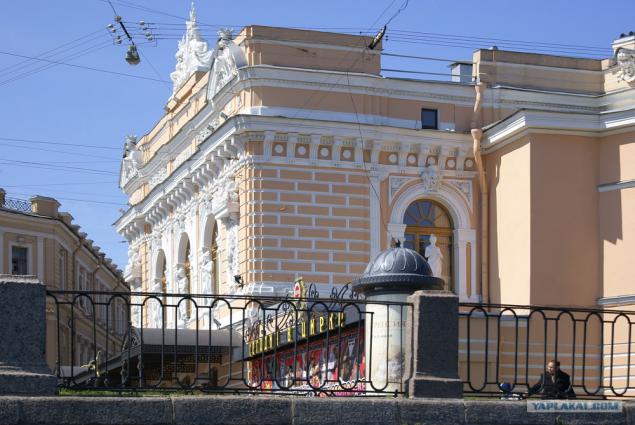
17. Under the bridge Belinsky
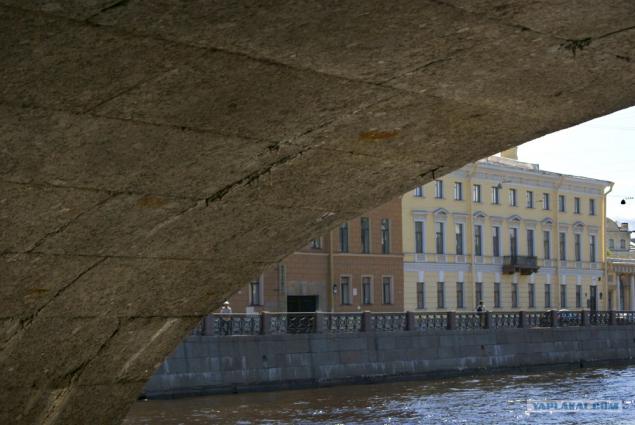
18. Anichkov Bridge with horses Klodt.
His name is required to bridge the lieutenant colonel-engineer Mikhail Anichkov, whose battalion during the time of Peter the First stationed in the so-called Fontanka Anichkov settlement.
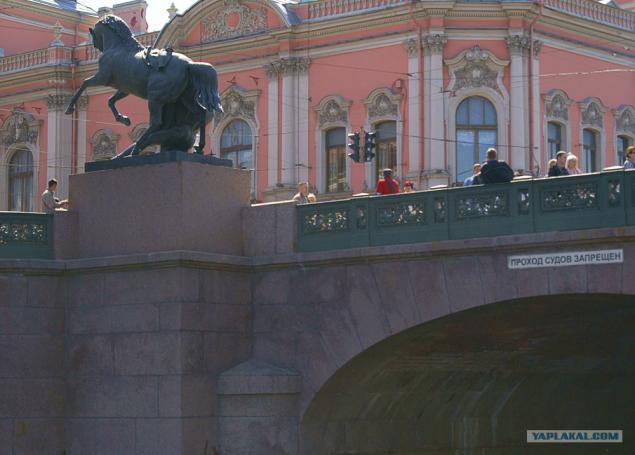
19. Anichkov Palace - one of the imperial palaces of St. Petersburg, near the Anichkov Bridge on the Fontanka River (Nevsky prospect, 39). The name of the palace was Anichkov Bridge. The oldest surviving building on Nevsky Prospect.
He began to build in 1741 by decree of Empress Elizabeth. At this time, Fontanka served outskirts of the city, Nevsky Prospect and was even the clearing. Thus, the palace was supposed to decorate the entrance to the capital. From the Fontanka to the palace was dug special channel ends at the entrance to the small harbor. Hence the unusual position of the palace, standing sideways to Nevsky Prospekt. Built palace reminiscent arranged next to a garden with fountains, flower beds Peterhof, Elizabeth gave Razumovsky, her favorite, and morganatic husband.
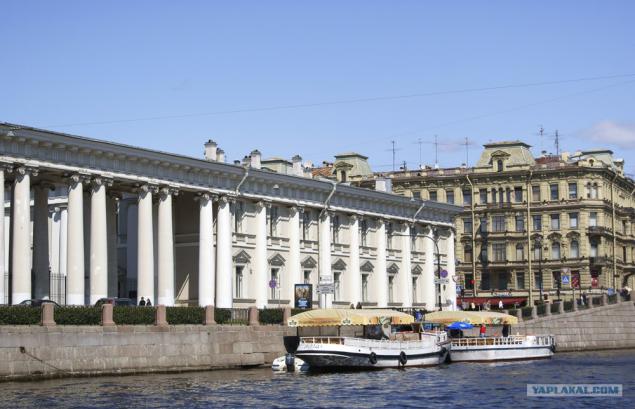
20. View of the Italian street with water.
Italian street runs between the Griboyedov Canal Embankment and the Fontanka River. At the beginning of the XVIII century on the left bank of the Fontanka River (on the site of the present building of the branch of the National Library) was the Italian palace. It carried the Assembly - public meetings in St. Petersburg nobility. The palace was built on the model of the Italian house of entertainment, so named by the Italian. Italian belonged to the palace garden was from them (palace and gardens) and got its name from the Italian street.
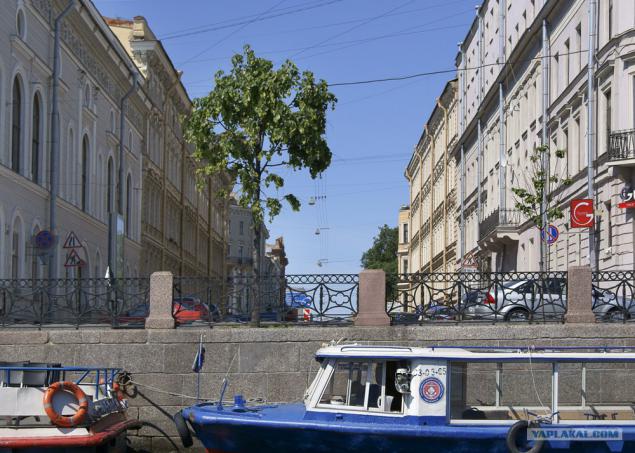
21. On the Fontanka very heavy traffic.

22. The house in which he lived Diaghilev

23. Church of Simeon and Anna the Prophetess (Simeon)
The land on which stands the Church of St. Simeon, was donated by Peter I of his three-year daughter Anna naming it in honor of the princess. The site stretches along the Fontanka from here up to the Nevsky Prospekt and from the river to the road of modern Ligovsky. In the years 1712-1714 on the orders of Peter was built a wooden church of the Archangel Michael. The temple was declared a court and before the construction of the predecessor of the Kazan Cathedral here took very solemn services.
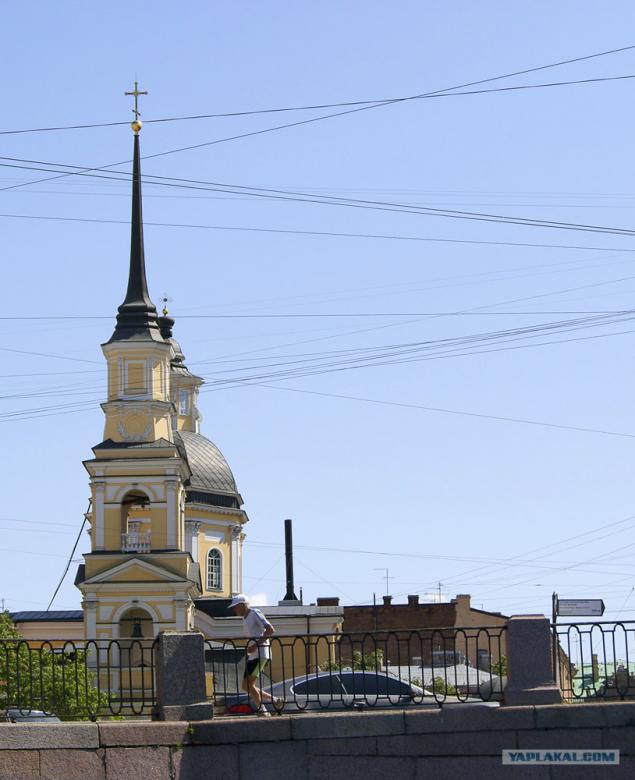
24. Turn on the Moika river.
1st Garden Bridge over the Moika is located in the alignment of Sadovaya Street and Swan Canal waterfront at the Mikhailovsky Castle.
Together with the first Engineering, Bas-Lebyazhya with granite edging the waterfront lawn at the Mikhailovsky Castle and the Summer Garden lattices, this site can be considered as probably the place to which today really shows what Petersburg received the title as the Venice of the North.
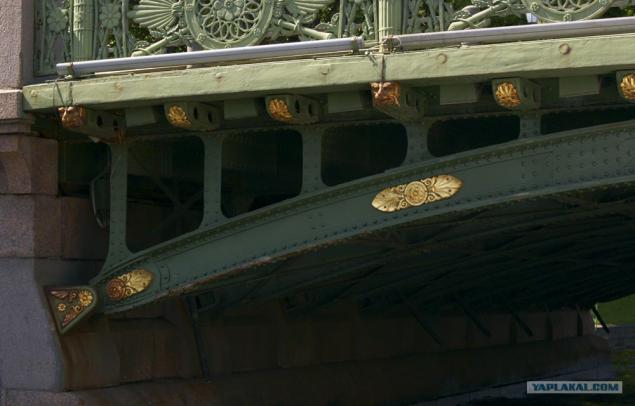
25. Small Stables Bridge Bridge located at the junction of the canal Griboedova Embankment and a petal trefoil, which together form a bridge with theater and deaf snag, only simulating the bridge.
Located in front of the square near the Cathedral of the Savior on Spilled Blood is an essential attribute of the wedding photo shoots newlyweds

26. Big Stables Bridge over the Moika is located in alignment Stables and Moshkova lanes.
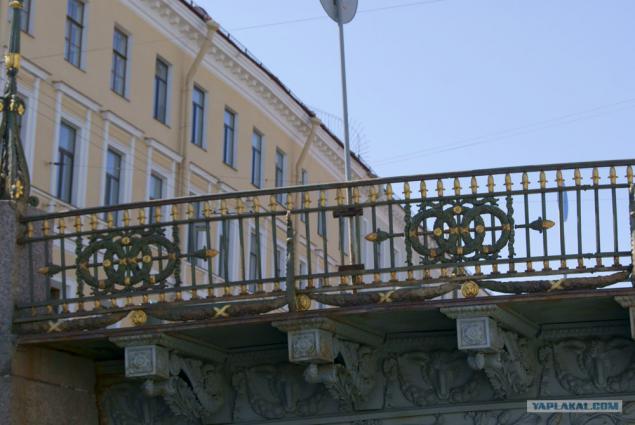
27. Cathedral of the Resurrection on the Blood Church of the Savior on Blood - odnoprestolny Orthodox Memorial Church of the Resurrection of Christ, erected in memory of the fact that in this place March 1, 1881 as a result of the attempt was mortally wounded Tsar Liberator - Emperor Alexander II (expression in the blood indicates the blood of the king). The temple was built as a monument to Tsar-Martyr funds collected throughout Russia.
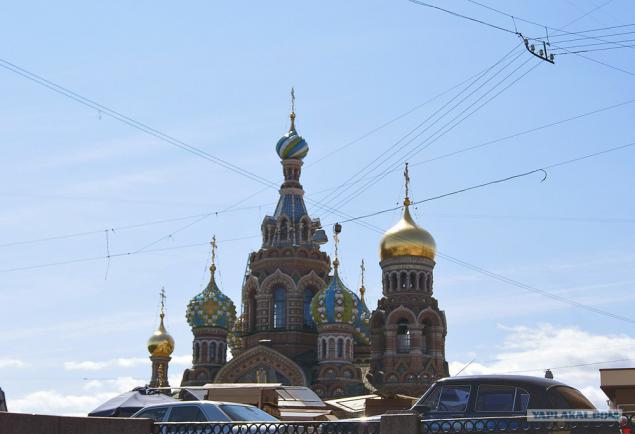
28. View of the building of the General Staff.
At present, the building belongs to the Leningrad Military District. In 1993, the East Wing of the General Staff transferred to the Hermitage.
Singing Bridge. The name comes from the fact that the bridge rests on the gates of Capella - center of musical culture of St. Petersburg

29. View VOLYNSKY LANE, between the embankment. R. Sinks and B. Stables Street. It paved in 1720. The 1740s was called "lane against the Swedish picks" because he was focused on it.

30. Turn to the Winter Canal, which will lead us back into the Neva.

31. Winter Canal
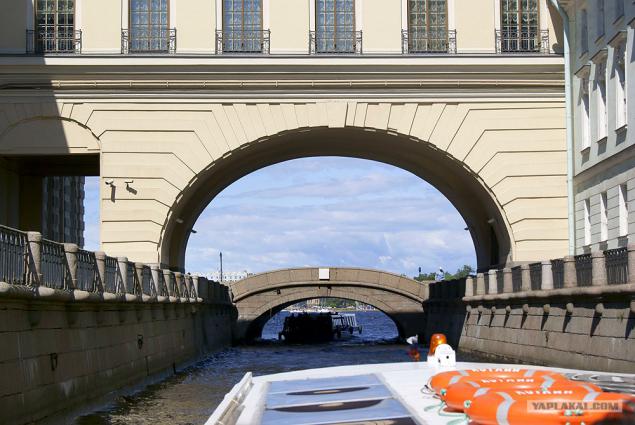
32. We have before us the arrow Vasilevsky Island
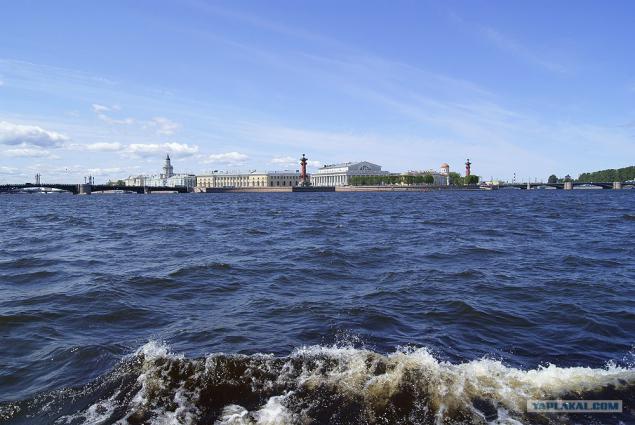
33. The project of the St. Petersburg Stock Exchange was designed by Quarenghi, construction began in 1783. But in 1787, the construction was suspended due to the fact that the building is being built does not match the appearance of the city and urban problems.
The development of the new project was entrusted to architect Tom de Thomon. In 1805-1810 the architect Tom de Thomon built on the empty space between the buildings of the new building of the Exchange that meets the needs of the growing economy of Russia. But later the building was used with a different purpose.
With the building of 1939-1941 is Central Naval Museum. In the 2000s, the city government plans to evict the museum building and the transfer market.
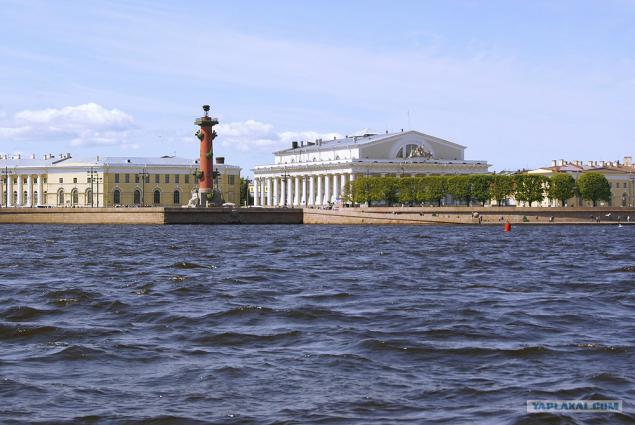
34. The building of Kunstkammer
Peter I during the "Grand Embassy" in 1697-1698 years examined large prosperous city of Holland and England. Saw and overseas offices "kunshtov" that is, curiosities, wonders. On the pages of the diary that Peter ordered to conduct, often glimpsed exclamation "exceedingly marvelous!". There is a record about the latest science and anatomy: "I saw the doctor anatomy: the whole interior raznyata differently - the human heart, lung, kidney veins ... that live in the brain - like a thread ...". Peter is very interested in such innovations and the king, do not skimp, he bought entire collections and individual items: books, utensils, tools, weapons, natural rarity. These items formed the basis of "The Emperor of the Cabinet", and then Peter's Kunstkammer, the first Russian science museum.

35. Hermitage, St. Isaac's Cathedral and the Admiralty.
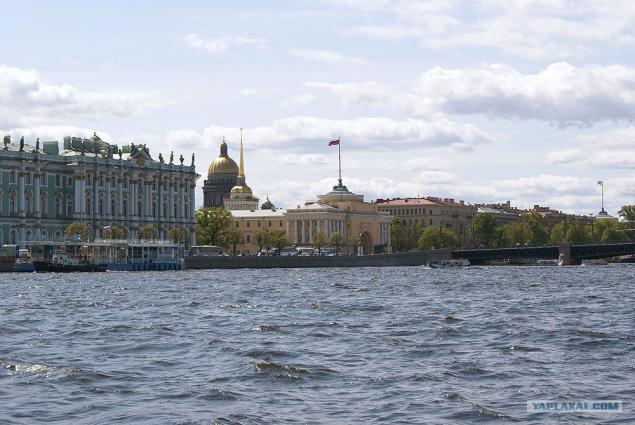
36. Palace Embankment
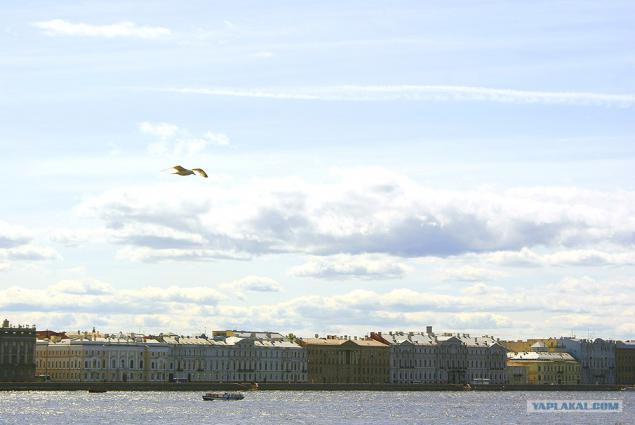
37. Seagulls over the Neva.
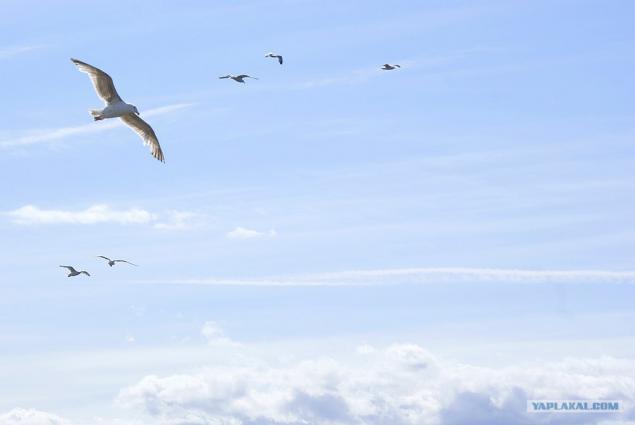
38. panoramka Troitsky Bridge with Commandant pier.
All pictures are clickable. All.

Source:
It starts from the bridge at St John and Paul Fortress, duration 1 hour, cost 350 pe.
38 photos and a bit of text

2. sailing past the bunny, which tourists leave coins.

3. Marble Palace
In the years 1768-1785, designed by Antonio Rinaldi built the Marble Palace, which Catherine II gave to her favorite Grigory Orlov. The gift was made for active participation in the events Orlova 1762, as a result of which the Empress was on the Russian throne. Earl began to reciprocate a gift - a huge diamond weighing 189, 62 carats, named "Eagles».
According to legend, the empress herself made a sketch of the future building and showed it to the architect. Knowing that the project was Catherine Rinaldi praised the work and immediately received a building permit. The building incorporated October 10, 1769, at its foundation was immured marble box with coins. Construction work led by Colonel artillery MI Mordvinians. Architectural supervision exercised Petr Egorov. On the construction of the Marble Palace daily work of about 100 masons and from 100 to 300 artillery Fusiliers. Catherine II, periodically visit the construction site and personally awarded the most distinguished employees.

4. sailed under the Troitsky Bridge.

5. The official residence of the Russian President's plenipotentiary representative in the North-West Federal District. Ship restaurant.

6. The legendary "Aurora" and the building of Nakhimov Naval College, established in 1944 to orphans whose parents died in the Great Patriotic War.

7. Foundry Bridge and the Big House (Foundry, etc., etc. 4).
Now the building of the FSB in St. Petersburg and Leningrad region. This house is dedicated detective television series "Foundry, 4" 2008. Earlier this place was the building of the District Court, burned in the February revolution.

8. Turn in the laundry room at the Fontanka River bridge. Right - Coffee House in the Summer Garden.

9. Laundry Bridge nazvyvaetsya so due to the fact that near - at the corner of St. Sergius Street (now the Tchaikovsky Street) and Fontanka - the palace was laundry.

10. On the territory of the Summer Garden, the site of the present house was Coffee Pavilion "Grotto", built in the years 1714-1725 and is now a monument of Peter the lost era. Who was its architect is unknown; however, suggest that it was one of the four famous architects of the time: A. Schluter, GI Mattarnovi, N. Michetti, M. Zemtsov.
In 1801, Groth was partially demolished on the orders of Paul I. After his murder the heir to the throne, Alexander I ordered to restore the building, but the drawings and plans for this were not enough. April 9, 1826 it was finally decided to rebuild the dilapidated Grotto.

11.

12.

13. Fontanka Embankment.

14. Mikhailovsky Castle.
His name Mikhailovsky Castle are therein shall temple of Archangel Michael, the patron saint of the Romanov dynasty, and fad Paul I, who took the title of Grand Master of the Order of Malta, called all his palaces "locks"; the second name - "Engineering" comes from being there since 1823. Main (Nicholas) Engineering School.
Beware of palace coups, Paul did not want to remain in the Winter Palace, determined to build his new residence. It is said that to reinforce the belief in the necessity of such a decision had spread a rumor that the soldiers standing at night on the clock in the Summer Palace, was a young man, surrounded by lights, who said: "Go to the Emperor and tell my will - so this place was erected a church and a house in the name of Archangel Michael. " The soldier, to be replaced from the post, reported the incident to his superiors, then the emperor. So supposedly and it was decided to build a new palace, it was given to him the name - St. Michael.
There is a legend associated with the murder of Paul in the castle: says that a few months before the death of the emperor appeared in St. Petersburg holy fool (according to some versions - Xenia of Petersburg), which foretold that to live it for so many years, how many letters in the inscription on the Iberian Gate a new palace . In the Biblical aphorism, "your house PODOBAET holy unto the Lord unto length of days" forty-seven characters. Forty-seventh year was Paul I, when he was killed.
The other, more well-known legend says that the ghost of the murdered emperor conspirators could not leave the place of his death. The ghost of the king began to see a platoon of soldiers garrison which transported military equipment, the new inhabitants of the palace - Diluting Corporal Ljamin school, and passers-by noticed the windows shining figure.

15. Castle, view from the Castle Street.

16. Circus

17. Under the bridge Belinsky

18. Anichkov Bridge with horses Klodt.
His name is required to bridge the lieutenant colonel-engineer Mikhail Anichkov, whose battalion during the time of Peter the First stationed in the so-called Fontanka Anichkov settlement.

19. Anichkov Palace - one of the imperial palaces of St. Petersburg, near the Anichkov Bridge on the Fontanka River (Nevsky prospect, 39). The name of the palace was Anichkov Bridge. The oldest surviving building on Nevsky Prospect.
He began to build in 1741 by decree of Empress Elizabeth. At this time, Fontanka served outskirts of the city, Nevsky Prospect and was even the clearing. Thus, the palace was supposed to decorate the entrance to the capital. From the Fontanka to the palace was dug special channel ends at the entrance to the small harbor. Hence the unusual position of the palace, standing sideways to Nevsky Prospekt. Built palace reminiscent arranged next to a garden with fountains, flower beds Peterhof, Elizabeth gave Razumovsky, her favorite, and morganatic husband.

20. View of the Italian street with water.
Italian street runs between the Griboyedov Canal Embankment and the Fontanka River. At the beginning of the XVIII century on the left bank of the Fontanka River (on the site of the present building of the branch of the National Library) was the Italian palace. It carried the Assembly - public meetings in St. Petersburg nobility. The palace was built on the model of the Italian house of entertainment, so named by the Italian. Italian belonged to the palace garden was from them (palace and gardens) and got its name from the Italian street.

21. On the Fontanka very heavy traffic.

22. The house in which he lived Diaghilev

23. Church of Simeon and Anna the Prophetess (Simeon)
The land on which stands the Church of St. Simeon, was donated by Peter I of his three-year daughter Anna naming it in honor of the princess. The site stretches along the Fontanka from here up to the Nevsky Prospekt and from the river to the road of modern Ligovsky. In the years 1712-1714 on the orders of Peter was built a wooden church of the Archangel Michael. The temple was declared a court and before the construction of the predecessor of the Kazan Cathedral here took very solemn services.

24. Turn on the Moika river.
1st Garden Bridge over the Moika is located in the alignment of Sadovaya Street and Swan Canal waterfront at the Mikhailovsky Castle.
Together with the first Engineering, Bas-Lebyazhya with granite edging the waterfront lawn at the Mikhailovsky Castle and the Summer Garden lattices, this site can be considered as probably the place to which today really shows what Petersburg received the title as the Venice of the North.

25. Small Stables Bridge Bridge located at the junction of the canal Griboedova Embankment and a petal trefoil, which together form a bridge with theater and deaf snag, only simulating the bridge.
Located in front of the square near the Cathedral of the Savior on Spilled Blood is an essential attribute of the wedding photo shoots newlyweds

26. Big Stables Bridge over the Moika is located in alignment Stables and Moshkova lanes.

27. Cathedral of the Resurrection on the Blood Church of the Savior on Blood - odnoprestolny Orthodox Memorial Church of the Resurrection of Christ, erected in memory of the fact that in this place March 1, 1881 as a result of the attempt was mortally wounded Tsar Liberator - Emperor Alexander II (expression in the blood indicates the blood of the king). The temple was built as a monument to Tsar-Martyr funds collected throughout Russia.

28. View of the building of the General Staff.
At present, the building belongs to the Leningrad Military District. In 1993, the East Wing of the General Staff transferred to the Hermitage.
Singing Bridge. The name comes from the fact that the bridge rests on the gates of Capella - center of musical culture of St. Petersburg

29. View VOLYNSKY LANE, between the embankment. R. Sinks and B. Stables Street. It paved in 1720. The 1740s was called "lane against the Swedish picks" because he was focused on it.

30. Turn to the Winter Canal, which will lead us back into the Neva.

31. Winter Canal

32. We have before us the arrow Vasilevsky Island

33. The project of the St. Petersburg Stock Exchange was designed by Quarenghi, construction began in 1783. But in 1787, the construction was suspended due to the fact that the building is being built does not match the appearance of the city and urban problems.
The development of the new project was entrusted to architect Tom de Thomon. In 1805-1810 the architect Tom de Thomon built on the empty space between the buildings of the new building of the Exchange that meets the needs of the growing economy of Russia. But later the building was used with a different purpose.
With the building of 1939-1941 is Central Naval Museum. In the 2000s, the city government plans to evict the museum building and the transfer market.

34. The building of Kunstkammer
Peter I during the "Grand Embassy" in 1697-1698 years examined large prosperous city of Holland and England. Saw and overseas offices "kunshtov" that is, curiosities, wonders. On the pages of the diary that Peter ordered to conduct, often glimpsed exclamation "exceedingly marvelous!". There is a record about the latest science and anatomy: "I saw the doctor anatomy: the whole interior raznyata differently - the human heart, lung, kidney veins ... that live in the brain - like a thread ...". Peter is very interested in such innovations and the king, do not skimp, he bought entire collections and individual items: books, utensils, tools, weapons, natural rarity. These items formed the basis of "The Emperor of the Cabinet", and then Peter's Kunstkammer, the first Russian science museum.

35. Hermitage, St. Isaac's Cathedral and the Admiralty.

36. Palace Embankment

37. Seagulls over the Neva.

38. panoramka Troitsky Bridge with Commandant pier.
All pictures are clickable. All.

Source:



